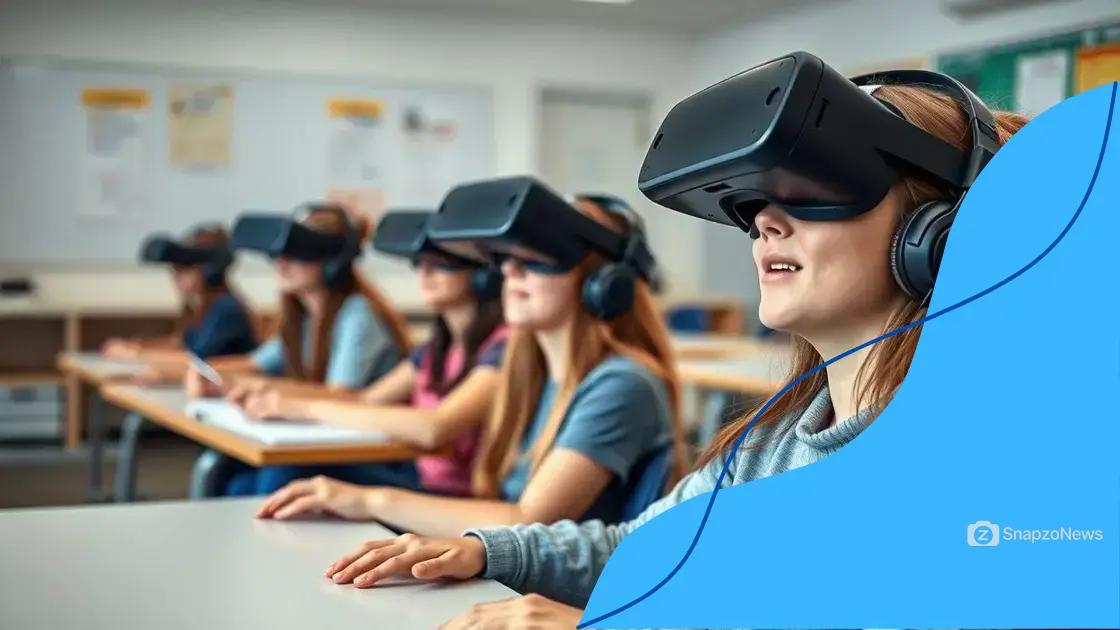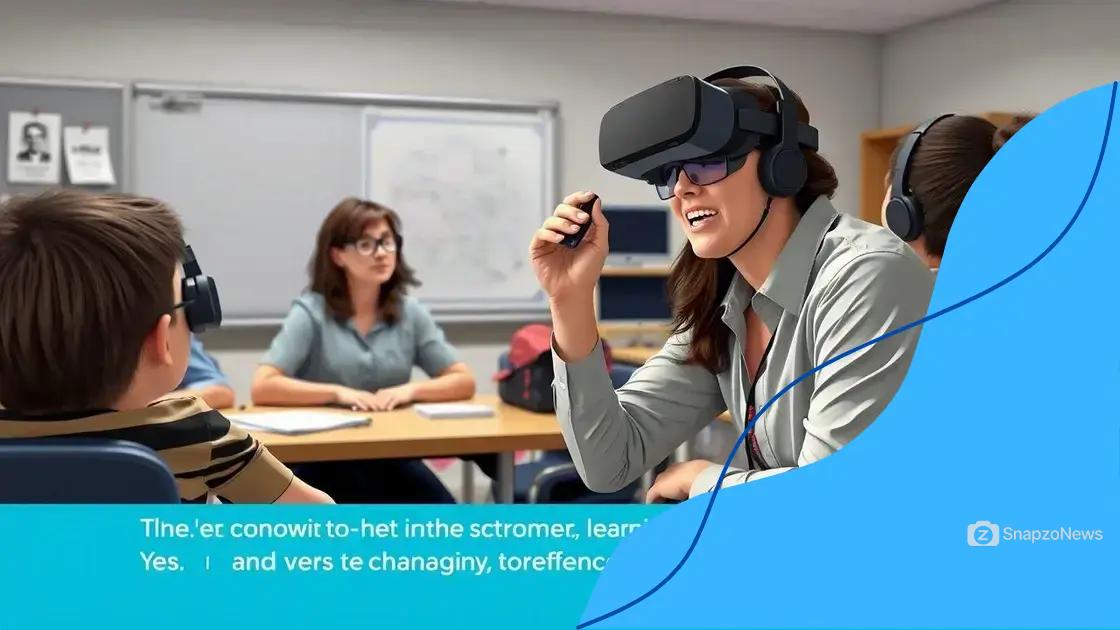Integrating virtual reality in education: a new frontier

Integrating virtual reality in education enhances engagement and personalization, providing immersive learning experiences while preparing students for future challenges through collaborative and adaptive technology.
Integrating virtual reality in education opens up exciting possibilities for immersive learning. Have you ever imagined studying history by walking through ancient ruins? This technology can make such experiences a reality.
Understanding virtual reality in education
Understanding virtual reality in education is essential for grasping how technology can reshape learning experiences. This innovative approach provides immersive environments that captivate student interest.
Through virtual reality, students can explore subjects like history or science in a way that textbooks cannot offer. Imagine attending a virtual field trip to the depths of the ocean or stepping inside a historical event. This level of interaction sparks curiosity and engagement.
The components of virtual reality in education
There are several key components that make virtual reality effective in the classroom:
- Immersive experiences: Students are placed in a 360-degree environment, making learning more engaging.
- Interactivity: They can interact with elements in the virtual world, reinforcing learning through active participation.
- Visualization: Complex concepts become easier to understand through visual representation.
Incorporating virtual reality requires thoughtful planning. Teachers should be aware of necessary resources and training to optimize its use. The technology must complement the curriculum, enhancing the educational experience without overwhelming it.
It’s also crucial to consider students’ diverse learning styles. Some may thrive in a virtual environment, while others might require traditional methods. Balancing these approaches can lead to a more inclusive education.
Challenges of using virtual reality
Despite its benefits, there are challenges in integrating virtual reality into education:
- Cost: Implementing VR technology can be expensive for schools.
- Technical issues: Lagging software or poor hardware can disrupt learning.
- Training: Teachers need adequate training to effectively use VR tools.
Understanding these factors is vital for educators looking to incorporate virtual reality into their teaching. Each challenge presents opportunities for growth and improvement. With careful consideration and planning, virtual reality can become an invaluable asset in modern education.
Benefits of virtual reality for students
Understanding the benefits of virtual reality for students is key to unlocking its full potential in education. This engaging technology can transform traditional learning experiences in exciting ways.
One major benefit of virtual reality is that it creates immersive learning environments. Students can explore worlds far beyond their classroom walls, such as the surface of Mars or the depths of the ocean. This makes lessons come alive, deeply enhancing student engagement.
Enhanced engagement and motivation
With virtual reality, students are often more motivated to learn. They experience less boredom and distraction, as they are actively involved in their education. This sense of adventure can lead to:
- Increased participation: Students are more likely to contribute and ask questions.
- Deeper understanding: Complex subjects become easier to grasp when students can visualize them.
- Improved retention: Active involvement helps students remember what they learned better.
The hands-on nature of virtual reality can cater to various learning styles. For visual learners, the visualizations provided can clarify concepts. Auditory learners benefit from audio cues, while kinesthetic learners can engage with the virtual environment directly.
Accessibility and safety
Another significant advantage is the ability to access experiences that may be otherwise impossible or unsafe. Virtual reality allows students to:
- Experience history: Walk through ancient ruins without leaving the classroom.
- Conduct science experiments: Safely try out experiments that could be hazardous in real life.
- Explore careers: Participate in field trips to various workplaces virtually to inspire future careers.
This technology promotes inclusivity, allowing all students access to an enriched learning environment. It’s a tool that can bridge gaps and provide opportunities for exploration and discovery.
Moreover, virtual reality can help students develop new skills. As they navigate virtual environments, they enhance their critical thinking, problem-solving, and teamwork abilities. Collaborating in a virtual setting fosters communication and interpersonal skills that are valuable in real-world situations.
Challenges of implementing virtual reality in schools

Implementing virtual reality in schools presents unique challenges that educators must navigate. While the benefits are clear, addressing these hurdles is essential for successful integration.
One significant challenge is the cost of technology. Acquiring VR headsets, software, and other necessary equipment can be a large investment for schools. Budget constraints often make this difficult, especially in underfunded districts. Schools must find creative ways to fund this technology, such as grants or partnerships with tech companies.
Technical issues and maintenance
Another hurdle educators face is technical issues. VR technology requires a solid infrastructure, including reliable internet and updated computers. Without these, the viewing experience can be poor, leading to frustration for both students and teachers. Additionally, regular maintenance is necessary to keep equipment functioning properly. This adds another layer of responsibility for school staff.
- Issues that arise include:
- Software updates that may create compatibility problems.
- Hardware malfunctions that lead to downtime.
- Need for technical training for faculty and students alike.
Training for educators is another considerable challenge. Teachers must learn how to use VR tools effectively, which can require time and ongoing professional development. Many educators may feel uncomfortable with new technology, presenting a barrier to implementation. Schools need to provide adequate training programs to help teachers feel confident in using virtual reality.
Adapting curriculum
Adapting the curriculum to fit virtual reality tools can also be complex. Lessons need to be redesigned to include VR platforms, which requires time and collaboration among teaching staff. This process can be daunting, particularly for schools that are not familiar with such technology.
Moreover, some subjects may lend themselves better to VR than others. Educators must carefully consider how to integrate VR into their teaching subjects while ensuring that the technology enhances rather than distracts from learning objectives.
Furthermore, schools need to address the ethical implications of using virtual reality. Exposure to some virtual environments might not be suitable for all students. Educators must be mindful of content appropriateness and the potential impact on students’ mental well-being.
Best practices for using virtual reality in classrooms
Implementing best practices for using virtual reality in classrooms can significantly enhance educational experiences. By following these guidelines, educators can maximize the impact of VR technology on student learning.
First, it’s essential to create a clear curriculum integration plan. Virtual reality should not be a standalone tool; instead, it should complement existing lessons. Teachers need to identify specific learning objectives that VR can help achieve. This approach ensures that technology is used effectively and meaningfully.
Engage students actively
One key practice is to actively engage students during VR sessions. This can include:
- Collaborative activities: Encourage teamwork by having students work together on tasks in the virtual environment.
- Facilitate discussions: Stimulate conversations about what they are experiencing and learning during VR sessions.
- Ask guiding questions: Prompt students with questions that encourage critical thinking and reflection.
Encouraging active participation not only makes learning more enjoyable but also reinforces understanding.
Provide clear instructions and support
Before diving into VR experiences, teachers should provide students with clear instructions. This will help minimize confusion when navigating virtual environments. Educators should ensure that all students know how to use the equipment and software appropriately.
Additionally, having a support system in place is crucial. Assigning peer mentors or providing additional resources can help students who may struggle with technology. This support fosters a positive learning environment and encourages students to explore VR confidently.
Another best practice involves regularly evaluating and tweaking VR content based on student feedback. This feedback loop allows teachers to understand what works best and what needs improvement. Adapting lessons based on this input helps keep students engaged and invested in their learning.
Monitor and assess learning outcomes
Finally, monitoring and assessing learning outcomes is essential. Teachers should utilize various assessment methods to measure how well students are achieving learning objectives through VR. This could include:
- Quizzes: Short assessments can gauge students’ understanding after VR experiences.
- Projects: Encourage students to create projects based on what they’ve learned in VR.
- Reflective writing: Have students write about their experiences and what they learned in the virtual environment.
This practice ensures that VR technology is not just a fun tool but a valuable educational resource that contributes to student success.
Future trends in virtual reality and education
Exploring future trends in virtual reality and education reveals the potential for even greater advancements in teaching and learning. As technology evolves, so does the way we approach education.
One trend is the increasing focus on personalized learning. Virtual reality can adapt to individual student needs, providing tailored experiences that cater to their learning pace and style. This personalization can enhance engagement and improve outcomes, ensuring that each student receives the education best suited for them.
Greater accessibility
Another exciting trend is improving accessibility for all learners. With advancements in VR technology, students from various backgrounds, including those with disabilities, will find more inclusive learning environments. Developers are working to create experiences that are universally accessible, ensuring everyone can benefit from virtual reality.
- Enhanced audio cues: Visual aids can be supplemented with audio descriptions for visually impaired students.
- Customizable environments: Virtual worlds can be tailored to meet sensory needs.
- Support for assistive technology: VR platforms may integrate with existing assistive devices.
This trend signifies a shift toward a more inclusive educational landscape where all students can thrive together.
Integration of artificial intelligence
Another prominent trend involves the integration of artificial intelligence (AI)
Additionally, AI can power virtual tutors within VR environments. These intelligent assistants can help students navigate challenging content, answering questions and providing guidance tailored to individual needs. This support can boost student confidence and understanding. Future trends also indicate a rise in social VR experiences. Collaborative virtual environments will enable students from different locations to learn together in interactive settings, bridging geographical barriers. This collaboration can foster a sense of community and teamwork, essential skills in today’s globalized world. As schools adopt these innovations, students will experience shared learning adventures, enhancing social skills and building friendships beyond their immediate surroundings. Furthermore, as technology progresses, we can expect a greater focus on gamification within VR education. Game-based learning has proven effective in engaging students. By incorporating game elements into VR experiences, educators can further motivate students, making learning fun and interactive. Virtual reality enhances engagement, provides immersive learning experiences, and caters to diverse learning styles, making education more effective. VR can adapt experiences to each student’s needs, allowing them to learn at their own pace and style, leading to better understanding and retention. Schools often struggle with costs, technical issues, and the need for teacher training to effectively use VR technology in the classroom. Future trends include greater accessibility, the integration of artificial intelligence, and social VR experiences that encourage collaboration among students.The rise of social VR experiences
FAQ – Frequently Asked Questions about Virtual Reality in Education
What are the main benefits of using virtual reality in education?
How can virtual reality personalize learning for students?
What challenges do schools face when implementing virtual reality?
What future trends can we expect in virtual reality education?
